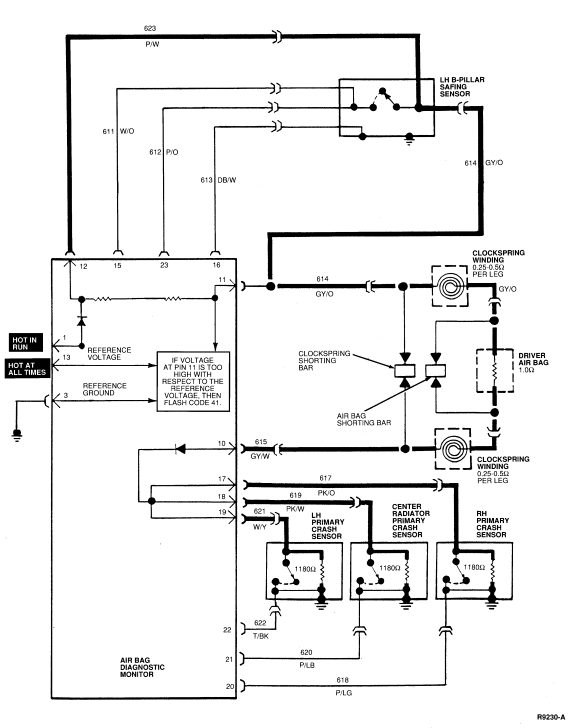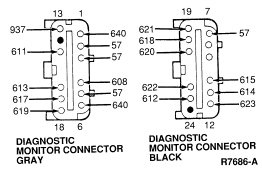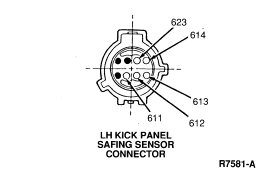Section 01-20B: Restraints, Passive—Supplemental Air Bag System | 1993 Mustang Workshop Manual |
DIAGNOSIS AND TESTING
Diagnostic Trouble Code 41
Primary Crash Sensor High Resistance Or Open In Circuit
Normal Description
Each primary crash sensor has an internal resistor. The diagnostic
monitor uses the resistor in the primary crash sensors in combination with the
two resistors inside the diagnostic monitor to create a tightly controlled
diagnostic voltage at Pin 11 (Circuit 614, GY/O). The primary crash sensors are
tied together inside the diagnostic monitor at Pins 17 (Circuit 617, PK/O), 18
(Circuit 619, PK/W) and 19 (Circuit 621, W/Y). Therefore, the resistors in the
sensors are connected in parallel. The parallel combination of all three sensor
resistors should be equal to 393 ohms. The resistance of each sensor should be
1180 ohms.
The resistors inside the diagnostic monitor are connected to Pins 11
(Circuit 614, GY/O) and 12 (Circuit 623, P/W) and are equal in value. Note that
Circuits 614 and 623 are tied together inside the safing sensor. Therefore, the
two resistors inside the diagnostic monitor are connected in parallel and will
function the same as one resistor of half the original value. Current flows
from Pins 1 and 6 through the resistors, out to Circuits 614 (GY/O) and 623
(P/W) on Pins 11 and 12, through the safing sensor and out to the driver side
air bag. Current flows through the driver side air bag and into Pin 10 (Circuit
615, GY/W). Current then flows from Pin 10 through the diode inside the
diagnostic monitor and out to the primary crash sensors through Pins 17, 18 and
19. The current flows through each primary crash sensor resistor and terminates
at the case ground of each sensor. Pin 11 is the midpoint of the resistor
network and voltage at Pin 11 will change with vehicle charging system voltage.
The expected voltage at Pin 11 is shown in the table below. The diagnostic
monitor measures the vehicle charging system voltage at Pin 13 (battery input).
By measuring the voltage at Pin 13, the diagnostic monitor can accurately
predict what the voltage at Pin 11 should be in a normal functioning system.
If the resistance of one or more of the primary crash sensors has
increased in value, then the parallel equivalent resistance of the primary
crash sensors will be greater than 393 ohms. When primary crash sensor
resistance increases, there is less overall resistance pulling the diagnostic
voltage down. Therefore, the voltage at Pin 11 will increase and the diagnostic
monitor will flash Diagnostic Trouble Code 41 to indicate high resistance (or
an open circuit) in one of the primary crash sensor circuits. Another situation
that may cause high voltage on Pin 11 is if resistance builds up across the
normally open safing sensor contacts. The safing sensor does not normally have
resistance across its contacts. If resistance appears across the safing sensor
contacts, then current will flow from Pin 15 (Circuit 611, W/O) through the
abnormal resistance across the safing sensor contacts and into Circuit 614
(GY/O). Since the voltage at Pin 15 is battery voltage or higher, this will
also cause an increase in voltage at Pin 11 and the diagnostic monitor will
flash Diagnostic Trouble Code 41.
Possible Causes
Higher than normal voltage on Pin 11 can be caused by:
- An open in one or more of the circuits between the diagnostic monitor
and the primary crash sensors. Circuits 617 (PK/O), 619 (PK/W), or 621
(W/Y) may have an open circuit in the wiring.
- An abnormally high resistance value across one or more of the primary
crash sensors. One or more of the primary crash sensor resistors may
have too high resistance or may be completely open circuit.
- Resistance across the safing sensor. The safing sensor is a
normally open switch with infinite resistance across its contacts. If the
safing sensor is damaged and some resistance builds up across the open
contacts, the voltage on Circuit 611 (W/O) will pull up the voltage on Circuit
614 (GY/O).
- An intermittent open between the positive terminal of the battery and
Pin 13 may cause the diagnostic monitor to determine that voltage on
Pins 17, 18 and 19 is too high with respect to the voltage on Pin 13.
CHARGING SYSTEM VOLTAGE
| Charging System Voltage |
Voltage at PIN NO. 10 |
Voltage at PIN NO. 11 |
Voltage at PIN NO. 17 |
Voltage at PIN NO. 18 |
Voltage at PIN NO. 19 |
| 9.0 |
1.9 |
1.9 |
1.4 |
1.4 |
1.4 |
| 9.5 |
2.0 |
2.0 |
1.5 |
1.5 |
1.5 |
| 10.0 |
2.1 |
2.1 |
1.6 |
1.6 |
1.6 |
| 10.5 |
2.2 |
2.2 |
1.7 |
1.7 |
1.7 |
| 11.0 |
2.3 |
2.3 |
1.8 |
1.8 |
1.8 |
| 11.5 |
2.4 |
2.4 |
1.9 |
1.9 |
1.9 |
| 12.0 |
2.5 |
2.5 |
2.0 |
2.0 |
2.0 |
| 12.5 |
2.6 |
2.6 |
2.1 |
2.1 |
2.1 |
| 13.0 |
2.7 |
2.7 |
2.2 |
2.2 |
2.2 |
| 13.5 |
2.7 |
2.7 |
2.3 |
2.3 |
2.3 |
| 14.0 |
2.9 |
2.9 |
2.4 |
2.4 |
2.4 |
| 14.5 |
3.0 |
3.0 |
2.5 |
2.5 |
2.5 |
| 15.0 |
3.1 |
3.1 |
2.6 |
2.6 |
2.6 |
| 15.5 |
3.2 |
3.2 |
2.7 |
2.7 |
2.7 |
| 16.0 |
3.3 |
3.3 |
2.8 |
2.8 |
2.8 |
Electrical Schematic—Diagnostic Trouble Code 41

DIAGNOSTIC TROUBLE CODE 41
41-1 VERIFY CONDITION
- Count diagnostic trouble code.
 Yes
Yes
GO to 41-2.
 No
No
Read the normal operation description for this diagnostic
trouble code. EXAMINE the diagnostic trouble code schematic and look for areas
where intermittent conditions would occur (connectors, splices, crimps,
etc.).
DO NOT proceed with Pinpoint Test until the code is flashing!
Failure to do so will result in needless replacement of the air bag system
components and repeat service.
41-2 CHECK FOR INTERMITTENT OPEN IN BATTERY FEED
- Turn ignition switch from OFF to RUN.
- Measure voltage between Pin 13 (+) and Pin 3 (-). Record
voltage as charging system voltage.
Is voltage measured within specification (within ±
1 volt)?
 Yes
Yes
TURN ignition switch to OFF. INSPECT all terminals and
connections between the positive terminal of the battery and Pin 13 of the
diagnostic monitor. This includes the fuse terminal crimps, splices, etc. GO to 41-3.
 No
No
GO to 41-4.
41-3 SERVICE POOR CONNECTIONS
During inspection of all terminals and connections, were any poor
connections found?
 Yes
Yes
SERVICE as required. RECONNECT system. VERIFY system.
REACTIVATE system.  No
No
REPLACE diagnostic monitor. RECONNECT system. VERIFY system.
REACTIVATE system.
41-4 CHECK PRIMARY CRASH SENSOR RESISTANCE
- Turn ignition switch OFF.
- Disconnect diagnostic monitor.
- Measure resistance of all primary crash sensor circuits from Pins 17, 18
and 19 of diagnostic monitor harness connector to Pin 3 (ground).
- All resistances should be 1180 ± 20 ohms.
Are all measurements within specifications?

 Yes
Yes
GO to 41-6.
 No
No
LOCATE and DISCONNECT primary crash sensor with abnormal
reading.
GO to 41-5.
41-5 MEASURE RESISTANCE OF ABNORMAL PRIMARY CRASH SENSOR
- Measure resistance across the two circuits in the primary crash sensor
connector.
Is reading within specification (1180 ± 20
ohms)?
 Yes
Yes
LOCATE and SERVICE open circuit in wiring harness for affected
sensor. RECONNECT system. VERIFY system. REACTIVATE system.  No
No
REPLACE affected crash sensor. RECONNECT system. VERIFY
system. REACTIVATE system.
41-6 CHECK RESISTANCE ACROSS PINS 15 AND 11
- Place ohmmeter on highest ohm scale available (200K ohms or AUTO).
- Measure resistance across Pin 15 (Circuit 611 (W/O)) and Pin 11 of the
diagnostic monitor harness connector.
Is resistance infinite (open)?
 Yes
Yes
LOCATE and SERVICE short between air bag circuits (614, 615)
and B+ in the wire harness. RECONNECT system. VERIFY system.
REACTIVATE system.  No
No
GO to 41-7.
41-7 CHECK SAFING SENSOR
- Disconnect LH B-pillar safing sensor.
- Measure resistance across Circuit 614 (GY/O) and Circuit 611 (W/O) wires
in safing sensor connector.
Is reading greater than 100,000 ohms?

 Yes
Yes
LOCATE and SERVICE short between Circuit 611 and 614 in wiring
harness. RECONNECT system. VERIFY system. REACTIVATE system. No
No
REPLACE LH B-pillar safing sensor. RECONNECT system. VERIFY
system. REACTIVATE system.
 No
No Yes
Yes No
No Yes
Yes No
No
 Yes
Yes No
No Yes
Yes No
No Yes
Yes No
No
 Yes
Yes No
No